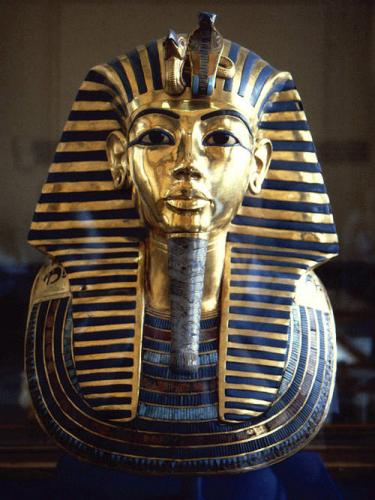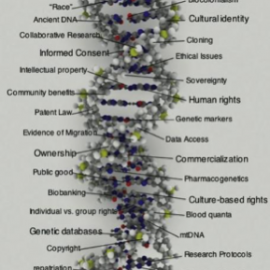By Alexa Walker
As genetic research is increasingly applied to new areas of study, including in archaeological and heritage contexts, a range of questions arise concerning the social, ethical, legal, and political implications of ancient DNA (aDNA).
This essay provides an introduction to the field of aDNA, examines emerging ethical and practical challenges in its application, and explores why information from ancient DNA research is important and relevant to people today.
WHAT IS ANCIENT DNA AND HOW DO WE DECODE IT?
DNA (short for deoxyribonucleic acid) is a sequence of some three billion nucleotides that encodes genetic information. DNA is found in all living things and is sometimes preserved in ancient human, animal, or plant remains. Variation in the exact sequence of nucleotides differs between individuals, groups, and species, and is thus useful for purposes such as individual identification and showing genetic/evolutionary relationships.
If any DNA is preserved in ancient samples, it is usually a very small amount. In order to “read” the small fragments of DNA, the polymerase chain reaction (PCR) is used. Using PCR, millions of copies of DNA can be amplified and analyzed from a very small starting amount of DNA (Brown & Brown 2011).
As with modern DNA, there are three types of aDNA that have been studied:
Nuclear DNA located within the nucleus of the cell, contains the most information about an individual. However, there isn’t always enough aDNA preserved in archaeological samples to be studied. Unlike mitochondrial and Y-chromosome DNA, nuclear DNA reflects both maternal and paternal ancestry.
Y-Chromosome is a type of nuclear DNA that is only present in males and is used to trace paternal ancestry.
Mitochondrial DNA (mtDNA) is found in the mitochondria of cells and can be used to trace maternal ancestry as it is passed down from a mother to her children. MtDNA is more likely to be preserved in ancient samples because there are 100–100,000 copies of mtDNA per cell, whereas there is only one copy of nuclear DNA per cell. Thus, the likelihood that mtDNA will be preserved in ancient remains is far greater than in the case of nuclear DNA. Also, mtDNA “evolves” more rapidly than nuclear DNA, allowing for more resolution of change in a short time period (Eshleman et al. 2003).
WHY ARE ARCHAEOLOGISTS INTERESTED IN STUDYING ANCIENT DNA
Human Evolution: DNA analysis has been used to investigate the interaction between early humans and Neanderthals. In 2010, the complete genome of a young Neanderthal woman was sequenced (Green et al. 2010). Additionally, recent studies have shown that modern humans inherited between 1–3% of their genomes from Neanderthals (Prüfer et al. 2014; Vernot & Akey 2014).
Historical Mysteries: Archaeologists from the University of Leicester identified the skeleton of King Richard III of England (AD 1452–1485) beneath a car park. The researchers confirmed the identity of the skeleton by matching his DNA to a known relative of King Richard, his 17th generation great nephew (Bucklet et al. 2013).
Ancient Disease: Disease causing germs, or pathogens, may still be present in the bones and tissue of past people. Ancient DNA has been used successfully to identify ancient cases Tuberculosis (Müller et al. 2014) and infection with Yersinia pestis, the pathogen responsible for the Black Death or Bubonic Plague (Harbeck et al. 2013).
Identifying Living Descendants: Using ancient DNA analysis, a direct genetic link between a woman who died 5,500 years ago, another who died 2,500 years ago, and a living Tsimshian woman from the Metlakatla First Nations was established (Cui et al., 2013).
DNA and Sex Identification: Depending on many factors, such as the condition of the remains and the age at death, it can be difficult to determine sex from human remains. DNA analysis provides a very specific and relatively simple method of distinguishing between males and females (Brown & Brown 2011).
Using DNA to identify animal or plant remains: DNA analysis can be used to distinguish between archaeological remains of animals and plants, which can be difficult otherwise. Cannon and Yang (2006) studied the DNA of salmon from the site of Namu, British Columbia. By learning which types of salmon were caught and at what point in the year, they gained valuable insight into subsistence practices and the local economy.
Migration Patterns: Comparing the DNA of ancient remains found in one part of the world to that of people living there today can help to determine the migration patterns of human populations as they spread out of Africa, into Europe and Asia, and eventually to the Americas. To try and shed light on the origins of the earliest inhabitants of the Americas, Raghavan et al. (2014) analyzed the Y chromosome of a 24,000-year-old individual from Mal’ta in south-central Siberia. The results indicate that present-day Native Americans may have mixed origins in both ancestral Western Eurasian and East Asian populations.
WHAT ARE SOME OF THE CHALLENGES TO CONDUCTING ANCIENT DNA RESEARCH?
Informed Consent: Deciding who needs to provide informed consent for ancient DNA research is challenging. The deceased can’t provide consent, so we must turn to their descendants to provide consent. But how do we define and identify a “descendant”? Do all descendants—who may number in the thousands or millions—have an equal claim over the remains of their ancestor? What about the remains of now extinct peoples where no definitive cultural or genetic link to living descendants can be established.
 When Informed Consent is Impossible: The mummy of Pharaoh Tutankhamun has been subjected to an endless battery of tests, including ancient DNA analysis. Using various lines of evidence, the boy king has been portrayed as an inbred child, infected with malaria, and afflicted with physical handicaps among many other alleged conditions (see Rühli & Ikram 2014). While the results of recent DNA tests have been called-into question, they highlight the ethical issue of revealing highly personal information from an individual whom did not provide consent (Holm 2001; Kaufmann et al. 2010). Do the dead have a right to keep their secrets?
When Informed Consent is Impossible: The mummy of Pharaoh Tutankhamun has been subjected to an endless battery of tests, including ancient DNA analysis. Using various lines of evidence, the boy king has been portrayed as an inbred child, infected with malaria, and afflicted with physical handicaps among many other alleged conditions (see Rühli & Ikram 2014). While the results of recent DNA tests have been called-into question, they highlight the ethical issue of revealing highly personal information from an individual whom did not provide consent (Holm 2001; Kaufmann et al. 2010). Do the dead have a right to keep their secrets?
Stakeholders in Ancient DNA Research: There are many stakeholders involved in ancient DNA research. A stakeholder is defined as “groups or individuals that might be affected by individual rights such as liberty, integrity, or dignity, but also include economic or political interests (Kaufmann et al. 2010: 609). It can be difficult to identity and define stakeholders in ancient DNA research: are they the direct genetic relatives of the deceased (who may now number in the millions)? Or are those who share social, cultural, or political ties to the deceased also considered stakeholders? From which stakeholders must informed consent be obtained for ancient DNA research, especially when the potential implications of such research may be widespread?
Identifying, consulting, and attaining approval from diverse stakeholders is a key challenge for those conducting ancient DNA research. In 2014, Rasmussen et al. (2014) sequenced the genome of a boy who died over 12,000 years ago. The remains of the young boy were found near tools from the Clovis culture, believed to represent some of the earliest inhabitants of North America. Analysis of the young boy’s DNA supports the conclusion that “contemporary Native Americans are descendants of the first peoples to settle successfully in the Americas” (pg. 228). Over the course of the research, the team consulted with representatives from nine tribes and later spoke about the difficulty they encountered during this process: which tribes should be consulted and when? How should they be contacted? What if one tribe wants the remains reburied and another provides permission for additional scientific testing? Despite efforts to consult the appropriate stakeholders, some Indigenous groups from Canada and the U.S. have voiced concern that they will be impacted by the research findings but were not appropriately consulted before the research began. This case highlights the difficulty of consulting with all appropriate stakeholders in ancient DNA analysis.
Intellectual Property: Who owns the information that arises from ancient DNA research? Who controls how the information is shared now, and in the future? Will the information be created and shared in a manner that is culturally appropriate according to the descendant communities? Several novel approaches have been applied in the context of DNA research:
The International Ancient Egyptian Mummy Tissue Banks of the Manchester Museum: In order to submit a sample to the museum, the depositor must verify that they are the “legal proxy decision makers regarding the possession and control of the body” and will retain property rights over any information produced through the future analysis of the ancient samples. Thus, if research conducted on the sample results in any sort of commercially profitable developments, the proxy decision maker (individual or community) will receive a share of the benefits (Elliott 2009).
“DNA on Loan”: Arbour and Cook (2006) propose that biological samples should be considered “on loan” to researchers. Thus, the researcher becomes the steward of the samples, but ownership remains with the individuals or communities who provide the samples. Because the ownership rights remain with the individual, consent must be obtained for any additional research, no matter how many years pass.

At very top, issues stemming from DNA research (graphic by G. Nicholas); middle, Tutankhamun's golden burial mask (J. Bodsworth via Wikipedia copyrighted free use); and above, excavating the Kwäday Dän Ts'ìnchi remains from the glacier, left to right are Greg Hare of Yukon Government Heritage Branch and Dr. Owen Beattie of the University of Alberta (photo by A.P. Mackie, B.C. Archaeology Branch).
Culturally Appropriate Ancient DNA Research: There may be unique ethical considerations depending on the individual or community involved in ancient DNA research. For some Indigenous groups, ancient DNA research “represents a serious violation of the sanctity” of deceased ancestors (Harry & Dukepoo 1998:8). Alternatively, ancient DNA studies may be seen as fulfilling cultural and spiritual values, and even confirming oral histories. The Sealaska Heritage Institute (representing the Tlingit, Haida, and Tsimshian people living in Southeast Alaska) and Champagne and Aishihik First Nations gave their permission for ancient DNA analysis to be conducted on the mummified remains of Kwäday Dän Ts’ìnchi, or “Long Ago Person Found” (Monsalve 2002; Worl 2014). Local oral histories linked Kwäday Dän Ts’ìnchi to Kaakaldeini, a young man who was injured while on a trading trip. With a storm fast-approaching, Kaakaldeini feared he would slow the rest of the group down and urged his companions to leave him behind on the glacier. Rosita Worl, President of the Sealaska Heritage Institute, explained that the motivation for participating in ancient DNA studies for the Tlingit, Haida, and Tsimshian stems from the concept of Haa Shágoon (Tlingit), Íitl' Kuníisii (Haida), and Hlaagigyadm (Tsimshian), which refers to the unity between Native people and their ancestors, as well as future generations (Worl 2014).
HOW CAN ANCIENT DNA RESEARCH IMPACT PEOPLE LIVING TODAY?
Even though archaeologists and geneticists are studying the DNA of ancient people, the information contained within the ancient genome can impact the lives of people living today. This is especially true for Indigenous people, who are sometimes referred to as a “genetically vulnerable” population. Four realms where ancient DNA research may hold implications for people today are:
Reducing identity to biology: A person’s identity is made up of many different factors, including biological and genetic connections, but also sociocultural and geographic factors, family histories, and lived experiences (Goodman, 2007). Is it problematic when one’s genetic identity eclipses other understandings of self? What problems arise when one’s identity is reduced to a molecular origin, such as when genetic markers are used for tribal enrollment (TallBear 2014).
Repatriation: Genetic information can play a role in the repatriation of human remains by confirming (or, in some cases, failing to confirm) a direct genetic link between an ancient individual and living individuals or groups. In the case of Kwäday Dän Ts’ìnchi, DNA analysis confirmed a genetic connection to people living in Canada and Alaska (Worl 2014). Yet, repatriation is based on cultural affiliation, which may be informed by, but is not exclusive to, biological identity.
Land Claims: Ancient DNA analysis may be helpful if it provides additional evidence of the long-term occupation of territory by a genetically similar group of people (i.e., the DNA between the ancient occupants matches the DNA of the present day occupants). However, it is always possible that DNA analysis may show a genetic discontinuity between ancient and modern populations. The potential for DNA to strengthen a group’s claim to the land is demonstrated by a study conducted by Cui et al. (2013), in which a direct genetic link between two ancient people and a modern Tsimshian woman was established, spanning over 5,000 years. This was interpreted as evidence of the long-term occupation of the land by ancestors of the people living there today. On the other hand, ancient DNA research conducted with the Aleutians in Alaska has provided evidence in support of archaeological theories that there was a population replacement event around AD 1000 (Smith et al. 2009)
The Profitability of Genetic Heritage: The Urus of Peru were able to confirm through DNA analysis their long standing claims that they are the descendants of the ancient Urus (the first people to have inhabited the Andes) (Kent 2013). This genetic information proved politically valuable in the longstanding territorial conflicts with the state of Peru and economically profitable in terms of tourist dollars.
References Cited
Arbour, L., & D. Cook (2006). DNA on Loan: Issues to Consider when Carrying Out Genetic Research with Aboriginal Families and Communities. Community Genetics 9(3): 153–160.
Brown, T., & K. Brown (2010). Biomolecular Archaeology: An Introduction. Wiley-Blackwell, Oxford.
Bucklet, R., M. Morris, J. Appleby, T. King, D. O’Sullivan, & L. Foxhall (2013). “The King in the Car Park”: New Light on the Death and Burial of Richard III in the Grey Friars Church, Leicester, in 1485. Antiquity 87(336): 519–538.
Cannon, A., & D.Y. Yang (2006). Early Storage and Sedentism on the Pacific Northwest Coast: Ancient DNA Analysis of Salmon Remains from Namu, British Columbia. American Antiquity 71(1): 123–140.
Cui, Y., J. Lindo, C. E. Hughes, J.W. Johnson, A. G. Hernandez, B.M. Kemp, J. Ma, R. Cunningham, B. Petzalt, J. Mitchell, David Archer, J.S. Cybulski, R. S. Malhi (2013). Ancient DNA Analysis of Mid-Holocene Individuals from the Northwest Coast of North America Reveals Different Evolutionary Paths for Mitogenomes. PLoS ONE 8(7): e66948.
Elliott, L. M. (2009). Property Rights of Ancient DNA: The Impact of Cultural Importance on the Ownership of Genetic Information. International Journal of Cultural Property 16(02): 103–129.
Eshleman, J., R. Mahli, & D. G. Smith (2003). Mitochondrial DNA Studies of Native Americans: Conceptions and Misconceptions of the Population Prehistory of the Americas. Evolutionary Anthropology 12(1): 7-18.
Green, R. E., and 55 authors (2010). A Draft Sequence of the Neandertal Genome. Science 328(5979): 710–722.
Harbeck, M., L. Seifert, S. Hänsch, D.M. Wagner, D. Birdsell, K.L. Parise, I. Wiechmann, G. Grupe, A. Thomas, P. Keim, L. Zöller, B. Bramanti, J.M. Riehm, H.C. Scholz (2013). Yersinia pestis DNA from Skeletal Remains from the 6th Century AD Reveals Insights into Justinianic Plague. PLoS Pathogen 9(5): e1003349.
Harry, D., & F. C. Dukepoo (1998). Indians, Genes and Genetics: What Indians Should Know About the New Biotechnology (1st ed.). Indigenous Peoples Council on Biotechnology: Nixon, Nevada.
Holm, S. (2001). The Privacy of Tutankhamen – Utilizing the Genetic Information in Stored Tissue Samples. Theoretical Medicine and Bioethics 22(5): 437–449.
Kaufmann, I. M., & F. J. Rühli (2010). Without “informed consent”? Ethics and Ancient Mummy Research. Journal of Medical Ethics 36(10): 608–613.
Kent, M. (2013). The Importance of Being Uros: Indigenous Identity Politics in the Genomic Age. Social Studies of Science 43(4): 534–556.
Monsalve, M. V., A. C. Stone, C.M. Lewis, A. Rempel, M. Richards, D. Straathof & D. V. Devine (2002). Brief Communication: Molecular Analysis of the Kwäday Dän Ts’inchi Ancient Remains Found in a Glacier in Canada. American Journal of Physical Anthropology 119(3): 288–291.
Müller, R., C.A. Roberts, & T.A. Brown (2014). Biomolecular Identification of Ancient Mycobacterium tuberculosis Complex DNA in Human Remains from Britain and Continental Europe. American Journal of Physical Anthropology 153(2): 178–189.
Prüfer, K., and 44 authors (2014). The Complete Genome Sequence of a Neanderthal from the Altai Mountains. Nature 505(7481): 43–49.
Raghavan, M., P. and 30 authors (2014). Upper Palaeolithic Siberian Genome Reveals Dual Ancestry of Native Americans. Nature 505(7481): 87–91.
Rasmussen, M., and 41 authors (2014).The Genome of a Late Pleistocene Human from a Clovis Burial Site in Western Montana. Nature 506(7487): 225–229.
Rühli, F. J., & S. Ikram (2014). Purported Medical Diagnoses of Pharaoh Tutankhamun, c. 1325 BC. Journal of Comparative Human Biology 65(1): 51–63.
Smith, S. E., M. G. Hayes, G.S. Cabana, C. Huff, J.B. Coltrain, & D.H. O’Rourke (2009). Inferring Population Continuity Versus Replacement with aDNA: A Cautionary Tale from the Aleutian Islands. Human Biology 81(4): 407–426.
TallBear, K. (2013). Native American DNA: Tribal Belonging and the False Promise of Genetic Science. University of Minnesota Press: Minneapolis, MN.
Vernot, B., & J.M. Akey (2014). Resurrecting Surviving Neandertal Lineages from Modern Human Genomes. Science 343(6174): 1017–1021.
Worl, R. (panelist). (2014, June 23). Genomics and Ancestry- Ethics, Origins, and Policy. Presented at the symposium A Spectrum of Perspectives: Native Peoples and Genetic Research, Washington, DC.
An abbreviated version of this essay can be found on IPinCH's Fact Sheet page.
Alexa Walker is the RA for the Bioarchaeology and Genetics Working Group, IPinCH Project and an M.A. Candidate in the Department of Archaeology at Simon Fraser University.






